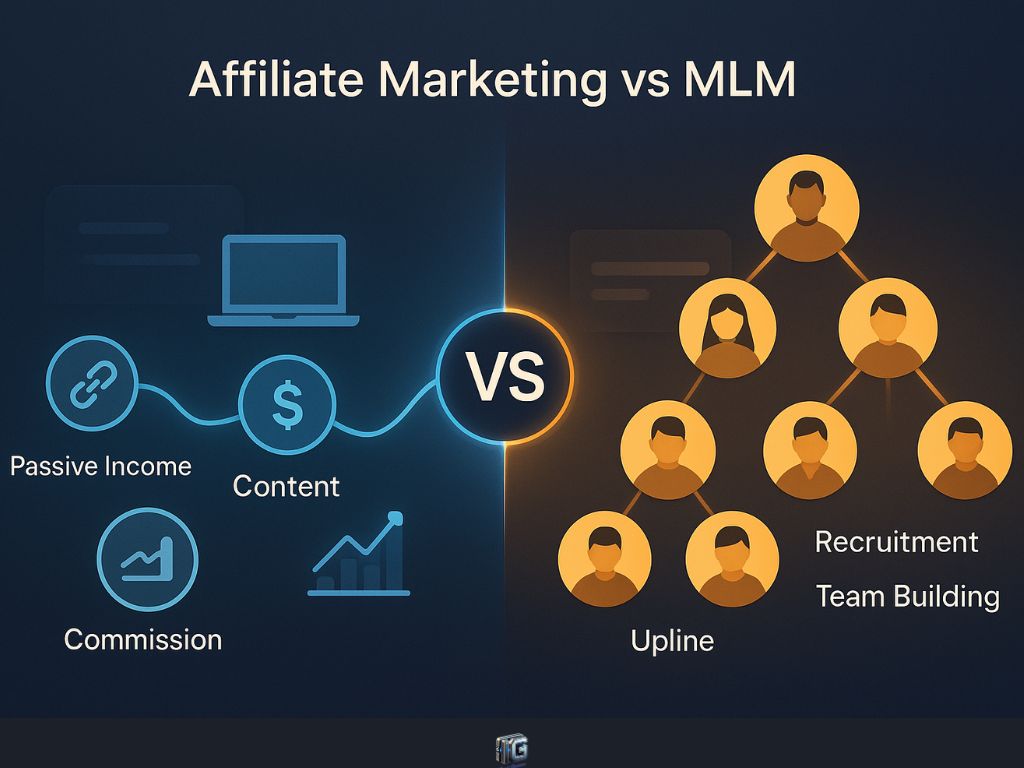Introduction
The terms get tossed around like they’re interchangeable, but affiliate marketing and multi-level marketing (MLM) follow completely different business models.
Both claim to offer flexibility, income potential, and a path to working independently.
Both are used by people trying to escape traditional 9-to-5 jobs.
But how they work, how you earn, and how each model scales? That’s where the real difference lies.
Before you join a platform, invest in tools, or sign up under someone’s link, it’s critical to understand exactly how each system operates and what that means for your income, time, and long-term sustainability.
This breakdown will walk you through the core mechanics, pros and cons, earning potential, and the hidden trade-offs you won’t see in the marketing pitches.
Key Takeaways
- Affiliate marketing pays commissions for promoting products or services without requiring team-building or recruitment.
- MLM (multi-level marketing) combines product sales with recruiting others into a sales network, often using tiered commission structures.
- Both models are legal and widely used, but they operate under very different strategies and expectations.
- Startup costs, earning potential, and time requirements vary greatly between the two.
- Understanding how each model works will help you make a smarter, more sustainable business decision.
Disclaimer: I am an independent Affiliate. The opinions expressed here are my own and are not official statements. If you follow a link and make a purchase, I may earn a commission.

Affiliate Marketing vs MLM: Core Business Model Breakdown
How Affiliate Marketing Works
Affiliate marketing is a performance-based model where individuals (affiliates) earn a commission by promoting another company’s product or service.
- You don’t create the product.
- You don’t handle fulfillment.
- You don’t manage customer support.
Instead, you use a unique tracking link. When someone clicks that link and makes a purchase, you earn a percentage of the sale.
The model is widely used across industries from software and online courses to physical goods and digital tools.
Affiliate marketers often promote through:
- Blogs or websites
- Email newsletters
- YouTube channels or podcasts
- Social media platforms
Commissions are typically one-time payments, though some programs offer recurring payouts for subscriptions or long-term services.
It’s a low-barrier model that allows individuals to monetize audiences, content, or traffic — without building a product or managing a team.
How MLM Works
Multi-level marketing (MLM) is a business model where individuals earn income through direct product sales and by recruiting others into a sales network.
Participants often called distributors, consultants, or reps buy products from the company, then sell them to customers at retail or promote the business opportunity to others.
They earn commissions not only on their own sales but also on the sales generated by the people they recruit (often referred to as their “downline”).
MLM organizations typically use tiered compensation plans, where income potential increases based on:
- The number of recruits
- Team performance
- Monthly product purchases (sometimes required to stay active)
Common MLM industries include:
- Health and wellness
- Skincare and beauty
- Household goods
- Supplements
While MLM is a legal business structure, it’s often confused with illegal pyramid schemes, which rely primarily on recruitment over product value.
Reputable MLM companies emphasize retail product sales, but most participants earn little or no profit after expenses, according to independent income disclosure statements.

Startup Costs and Risk: Affiliate Marketing vs Multi-Level Marketing
Affiliate Marketing Startup Costs
Affiliate marketing typically has low startup costs. Many affiliate programs are free to join, and there is no requirement to purchase or stock products. You can start promoting with just a smartphone and a social media account, though most serious affiliates invest in:
- A website or blog
- Email marketing software
- Paid traffic (optional)
- Tools for tracking, analytics, or funnel building
There’s no ongoing obligation to spend money each month, and affiliates can promote multiple companies at the same time. This makes it accessible for beginners and scalable for experienced marketers.
The main investment is time, learning how to drive traffic, build trust, and convert readers or viewers into buyers.
MLM Startup Costs
Most MLM companies require an upfront purchase to get started, often in the form of a “starter kit” or product package. This can range from $50 to several hundred dollars. In addition to the initial investment, many companies encourage or require:
- Monthly product purchases (auto-ship)
- Business tools (back office access, websites, samples)
- Event attendance or team training
- Inventory for personal sales or demos
These recurring costs can add up quickly, especially if income is slow to build. While some participants earn enough to cover their expenses, a large percentage do not, according to company-provided earnings disclosures.
For many, the financial risk lies not in the one-time purchase, but in the ongoing commitment required to remain active or qualify for commissions.
The Blurred Lines: New Companies in the Digital Age
In recent years, the line between traditional MLM and affiliate marketing has started to blur, especially with the rise of digital platforms.
Some companies now offer digital products (like courses, software, or memberships) through commission structures that look like affiliate marketing on the surface, but include:
- Multi-tiered payouts (you earn from people you refer and the people they refer)
- Monthly qualification requirements
- “Teams” or “networks” tied to rank or payout thresholds
- Language that mimics coaching, community, or creator support, but follows classic MLM frameworks
At the same time, some affiliate marketing programs have introduced:
- Recurring commissions (subscriptions, SaaS products)
- Referral team bonuses or second-tier overrides
- Private affiliate networks with higher earning potential
These hybrid models are not inherently good or bad, but they make it more important than ever to read the fine print.
If a company pays you for building a team, sets monthly purchase rules, or ties commissions to rank, it likely leans toward MLM.
If you’re only paid for direct sales through your link, with no team-building requirements, it’s affiliate marketing.
Understanding how modern platforms structure earnings helps you make an informed decision, especially when new opportunities look like both.

Income Potential: Real vs Promised
Affiliate Marketing Income Path
In affiliate marketing, your income is directly tied to performance. You promote a product or service using your unique tracking link, and you earn a commission only when someone makes a purchase through that link.
There are no guaranteed payouts.
No commissions for signing people up.
No team performance to manage.
Income potential depends on:
- The value of the product you’re promoting
- The commission rate (often 10%–50%, sometimes recurring)
- The amount of traffic and conversions you can generate
Top affiliate marketers often use content (blogs, videos, email, etc.) to build systems that scale. While early income is typically low, consistent traffic and trust-building can lead to high-earning, semi-passive income streams over time.
MLM Income Claims vs Reality
Multi-level marketing companies often showcase testimonials from high earners, but these cases are outliers. Most compensation plans are complex, with earnings dependent on personal sales, recruitment, team activity, and meeting monthly qualifications.
Key realities reported by most MLM income disclosures:
- A large percentage of participants earn less than a few hundred dollars per year
- A smaller percentage break even or earn modest profits
- Only a tiny fraction earn full-time or six-figure incomes typically after years of effort, team building, and retention management
Success often depends less on product sales and more on team recruitment and volume. Income can also fluctuate based on rank changes, team churn, or shifting requirements.
While earning big is possible in both models, affiliate marketing tends to reward individual effort and marketing skill, while MLM relies more on network growth and retention.

Network Marketing vs Affiliate Marketing: Scalability and Time Freedom
Affiliate Marketing: Built for Leverage
Affiliate marketing allows individuals to scale their income through systems — not time. Once content, funnels, or email sequences are built, they can generate traffic and sales without constant hands-on work.
This leverage comes from:
- SEO content that ranks and drives passive traffic
- Email autoresponders that sell 24/7
- Paid ads that convert while you sleep
- Evergreen video or social content that keeps earning
While building these systems takes effort upfront, the ability to generate income without trading hours for dollars makes affiliate marketing attractive to those seeking time freedom.
There are no teams to manage, no inventory to track, and no meetings or rank maintenance to deal with.
MLM: Dependent on Ongoing Activity
In MLM, income is often tied to consistent action, both personal and from the team. Even with a downline, most reps are expected to:
- Stay active by hitting monthly sales or purchase targets
- Recruit and train new members
- Manage team performance
- Attend calls, events, and product launches
As teams grow, so does the responsibility. While some high-level leaders build semi-passive income over time, the vast majority must remain actively involved to maintain rank, prevent churn, and keep commissions flowing.
This structure often limits scalability unless you’re highly skilled at leadership, motivation, and team management and enjoy ongoing interaction and accountability.

Network Marketing vs Affiliate Marketing: Social Stigma and Long-Term Reputation
Affiliate Marketing: Quiet and Scalable
Affiliate marketing typically happens behind the scenes. Most consumers don’t even realize they’re clicking an affiliate link, they’re simply buying something recommended in content they trust.
Because there’s no pressure to recruit or pitch friends, affiliate marketers can build their businesses through:
- Value-driven content
- SEO, paid ads, or email
- Brand partnerships or reviews
This quiet, non-invasive approach allows marketers to scale without risking personal relationships or appearing pushy. It’s common in mainstream media, influencer marketing, and professional digital entrepreneurship, making it more accepted, even respected, in many online circles.
MLM: Often Linked to Social Pressure
MLM, on the other hand, often relies on personal outreach to grow. This includes inviting friends and family to presentations, sharing product testimonials on social media, and encouraging others to join the opportunity.
While some enjoy the community and in-person approach, this strategy can lead to:
- Fatigue or discomfort among personal networks
- Reputation challenges if the product or pitch is overused
- Association with “get rich quick” schemes or unverified claims
Even when the products are high quality, the recruitment-heavy structure can create tension, both socially and professionally. In some industries, being tied to an MLM brand can affect how seriously others take your business efforts.

Affiliate Marketing vs MLM: Which One Fits Your Goals?
When Affiliate Marketing Makes Sense
Affiliate marketing is often a better fit for individuals who:
- Prefer working independently
- Enjoy creating content (blogs, videos, email, etc.)
- Want to build income through systems and automation
- Are comfortable learning digital tools and strategy
- Value long-term, scalable, low-maintenance business models
This path is ideal for creators, solopreneurs, and marketers who want to build online assets that grow over time without relying on team-building or personal sales pressure.
When MLM Might Be a Fit
MLM may appeal more to those who:
- Thrive in group environments
- Enjoy direct selling and social outreach
- Are energized by networking, events, and live presentations
- Want to build income through relationship-based leadership
- Prefer working within a structured, product-based system
Some people enjoy the sense of community, incentives, and recognition found in MLM environments. However, success usually requires consistent personal effort and comfort with recruiting.

Affiliate Marketing vs MLM: Migration and Switching Factors
From MLM to Affiliate Marketing
Many individuals who leave MLM eventually explore affiliate marketing often drawn to the flexibility and lower pressure.
Transitioning can be straightforward, but success may require learning new skills, including:
- Digital content creation (writing, video, email)
- Traffic generation (SEO, ads, social)
- Tracking and analytics tools
- Affiliate program platforms and payouts
One key difference is the mindset: affiliate marketing doesn’t rely on hype or team energy, it rewards clear messaging, consistency, and audience trust.
From Affiliate Marketing to MLM
Less common, but possible some affiliate marketers move toward MLM when looking for:
- Community or mentorship
- A more social business model
- Tangible products to promote offline
- A team-building dynamic they find motivating
However, the switch may come with trade-offs:
- Less automation
- More personal outreach
- Monthly product requirements or rank goals
Understanding those differences is critical before making a switch or layering one model on top of the other.

Frequently Asked Questions (FAQs)
Is affiliate marketing easier than MLM?
Not necessarily it depends on your strengths. Affiliate marketing requires digital skills like content creation and traffic generation. MLM often requires strong interpersonal skills, consistent outreach, and team leadership. The “easier” path depends on your personality and preferred way of working.
Can you really make passive income with MLM?
Some top earners in MLMs earn residual income through their downlines. However, this usually takes years to build, requires team maintenance, and often depends on meeting ongoing qualifications. Passive income in affiliate marketing is more tied to system-building and content that scales.
Why do most people fail at MLM?
MLM has a high failure rate due to high turnover, recurring product costs, and recruitment challenges. Many participants struggle to build a large enough team or customer base to generate sustainable income.
What tools do affiliate marketers need?
At minimum: a platform to publish (website, YouTube, etc.), an email list, and tracking links. Many affiliates also use SEO tools, email marketing platforms, and funnel builders to scale their efforts.
Can you do both affiliate marketing and MLM?
Technically yes, but they require different strategies. Some people promote MLM products using affiliate-style content, but blending both models can dilute your messaging and create confusion if not handled carefully.

Conclusion: Choose What Builds, Not Drains
Affiliate marketing and MLM may seem similar on the surface flexible, independent, commission-based. But once you look closer, the difference is clear.
Affiliate marketing is built for scale, automation, and long-term growth.
MLM relies on social selling, team management, and ongoing recruitment.
One rewards systems. The other demands energy.
One grows through leverage. The other through outreach.
That doesn’t make one good and the other bad, it makes them fundamentally different business models.
If you want to build a brand quietly, create value, and grow income through content and digital systems, affiliate marketing may be the better fit.
But no matter what you choose, choose with clarity, not hype.
Next: Read our High-Ticket Affiliate Marketing Guide and check out our Network Marketing Guide.
1 Comment
Network Marketing: How It Works and Why It’s Controversial - Ismel Guerrero. · May 18, 2025 at 8:20 am
[…] To learn more about their differences check out our Affiliate Marketing vs MLM Breakdown. […]